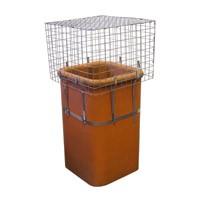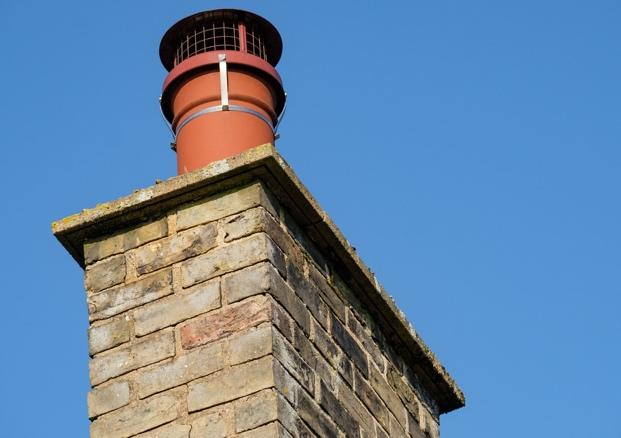Standing in your garden on a windy day, you might notice smoke being blown back down your neighbour’s chimney, or perhaps you’ve experienced the frustration of lighting a fire only to have your living room fill with smoke. These common problems across Cambridge and surrounding areas often have a surprisingly simple solution – a chimney cowl.
If you’re wondering whether your chimney might benefit from a cowl, you’re asking the right question. Understanding what these devices do, when they’re needed, and how they work can help you make an informed decision about whether investing in one makes sense for your property.
The reality is that not every chimney needs a cowl, but for those that do, the difference can be transformative. Let’s explore what chimney cowls are, the problems they solve, and how to determine if your chimney might be a good candidate for one.
What Exactly Is a Chimney Cowl?
A chimney cowl is a fitted cover that sits on top of your chimney pot, designed to improve your chimney’s performance while protecting it from weather and wildlife. Think of it as a specialised cap that does much more than simply keeping rain out.

Basic components of a chimney cowl:
- A protective hood or cover
- Side openings for smoke and gas escape
- A mounting system that fits securely to your chimney pot
- Weather-resistant materials designed for outdoor exposure
How they work: Unlike a simple rain cover, cowls are engineered to create or improve the natural draw that pulls smoke and gases up and out of your chimney. They work by manipulating airflow around the chimney top, using wind to enhance rather than hinder the escape of combustion products.
The key principle is that properly designed cowls use the Venturi effect – where wind passing over the cowl creates a low-pressure area that helps draw smoke upward, even in challenging weather conditions.
Properties throughout Ely, Newmarket, and Royston often benefit from cowls due to the area’s exposed locations and variable wind patterns that can affect chimney performance.
Common Problems That Cowls Can Solve
Before considering whether you need a cowl, it’s helpful to understand the specific problems they’re designed to address. Many homeowners live with chimney issues without realising there’s a relatively straightforward solution.
Downdraught Issues This is perhaps the most common problem cowls solve. Downdraught occurs when wind blows smoke back down your chimney instead of allowing it to escape naturally. You’ll notice this when:
- Smoke enters your room instead of going up the chimney
- Your fire burns poorly or goes out frequently
- You smell smoke in the house when using your fireplace
Weather-Related Problems Exposed chimneys face constant weather challenges that cowls can help manage:
- Rain entering the chimney and damaging the flue
- Snow blocking the chimney opening
- Strong winds creating pressure that affects performance
Wildlife Protection Birds, particularly the jackdaws common throughout Saffron Walden, St Ives, and surrounding areas, see chimneys as ideal nesting sites. A properly designed cowl prevents access while maintaining proper ventilation.
Debris and Leaf Blockages Properties near trees often experience problems with leaves, twigs, and other debris falling into chimneys. Cowls provide a barrier while allowing smoke to escape freely.
Different Types of Cowls for Different Problems
Not all cowls are created equal, and choosing the right type depends on your specific situation. Understanding the main categories helps you make an informed decision about what might work best for your property.
Static Cowls These are the most common type, with no moving parts and designs that rely on their shape to improve airflow. They include:
- Anti-downdraught cowls: Specifically designed to prevent wind from pushing smoke back down
- Rain guards: Simple covers that keep weather out while allowing smoke to escape
- Bird guards: Mesh or barrier designs that prevent wildlife access
Rotating Cowls These feature a spinning top section that’s designed to create suction as it turns in the wind. While potentially effective, they require regular maintenance to keep moving parts functioning properly.

Specialist Cowls Some situations require specialised solutions:
- Ridge mounted systems: For difficult roof configurations
- Conservation-approved designs: For listed buildings and conservation areas
- Multi-fuel specific cowls: Designed for different types of heating appliances
Properties in Huntingdon, St Neots, and Bishop’s Stortford often feature conservation restrictions that limit cowl options, making professional advice particularly valuable in these areas.
When You Might Need a Cowl
Determining whether your chimney would benefit from a cowl involves assessing both your current problems and your property’s characteristics. Not every chimney needs one, but certain situations make cowls particularly beneficial.
Clear indicators you might benefit from a cowl:
- Regular problems with smoke entering your room
- Difficulty lighting or maintaining fires
- Rain or moisture problems in your fireplace
- Evidence of bird nesting activity
- Chimney located in an exposed or windy position
Property characteristics that suggest cowl benefits:
- Chimneys that are shorter than surrounding buildings or trees
- Properties in exposed locations with consistent wind problems
- Older chimneys with poor natural draw
- Chimneys serving appliances that require consistent ventilation
When cowls might not be the answer:
- Internal chimney problems like damaged flue linings
- Structural issues with the chimney itself
- Problems caused by incorrect appliance installation
- Issues that require repair rather than performance enhancement
The Investment Consideration
Understanding the costs and benefits helps you make a practical decision about whether a cowl makes financial sense for your situation.
Immediate benefits:
- Improved fire performance and reduced smoke problems
- Protection from weather damage
- Prevention of wildlife nesting
- Reduced maintenance requirements
Long-term value:
- Fewer chimney cleaning requirements due to reduced debris entry
- Protection of chimney structure from weather damage
- Improved efficiency of heating appliances
- Reduced risk of expensive repairs from water damage
Cost considerations:
- Initial purchase and installation costs
- Ongoing maintenance requirements
- Potential savings from improved performance
- Protection against future repair costs
Professional assessment value: Having a HETAS registered professional evaluate your specific situation ensures you invest in the right solution. An unnecessary cowl provides no benefit, while the wrong type of cowl can create new problems.
Installation and Professional Considerations
While cowls might seem like simple devices, proper installation is crucial for both effectiveness and safety. Understanding what’s involved helps you appreciate why professional installation is typically the best approach.
Why professional installation matters:
- Correct sizing and fitting for your specific chimney pot
- Proper weatherproofing to prevent water ingress
- Secure mounting that withstands weather conditions
- Compliance with building regulations and insurance requirements

Installation process: Professional installation typically involves roof access, precise measurements, and secure fixing methods that ensure the cowl remains effective over time. This work requires proper safety equipment and experience working at height.
Maintenance considerations: Even the best cowls require occasional maintenance to perform effectively. Professional installation includes guidance on what to watch for and when maintenance might be needed.
Conservation and planning considerations: Properties in conservation areas or with listed building status may require approval before cowl installation. Professional installers understand these requirements and can advise on appropriate solutions.
Making the Decision
Deciding whether to invest in a chimney cowl shouldn’t be a guess. Professional assessment provides the information you need to make an informed choice about what’s best for your property.
Questions to consider:
- What specific problems are you trying to solve?
- Have you ruled out other potential causes?
- What type of cowl would be most appropriate for your situation?
- Are there any planning or conservation considerations?
The assessment process: Professional evaluation typically includes visual inspection of your chimney, assessment of draw and performance issues, identification of specific problems, and recommendations for appropriate solutions.
Alternative solutions: Sometimes problems that seem like they need cowls actually require different solutions – perhaps repairs, adjustments, or other modifications. Professional assessment ensures you address the real issue rather than just the symptoms.
FAQs
Do all chimneys need cowls?
No, many chimneys function perfectly well without cowls. They’re typically beneficial for chimneys with specific performance issues, exposure problems, or wildlife concerns. Professional assessment determines if a cowl would provide genuine benefits.
Will a cowl affect my chimney’s performance?
A properly selected and installed cowl should improve performance by addressing specific issues like downdraught or weather problems. However, the wrong cowl can create problems, which is why professional advice is valuable.
Can I install a cowl myself?
While possible, cowl installation involves roof work and precise fitting that’s best handled professionally. Incorrect installation can create safety hazards and may not effectively address the problems you’re trying to solve.
Do cowls require planning permission?
Most cowl installations are considered permitted development, but properties in conservation areas or with listed building status may require approval. Professional installers can advise on requirements for your specific situation.
How long do chimney cowls last?
Quality cowls properly installed can last many years with minimal maintenance. Lifespan depends on materials, weather exposure, and maintenance, but professional installation maximises durability and effectiveness.
What maintenance do cowls require?
Regular visual inspection for damage or blockages, occasional cleaning to remove debris, and periodic checks that mounting remains secure. Professional installation includes guidance on maintenance requirements for your specific cowl type.
Why Choose Ablewight Chimney Services?
Certified Expertise As members of the Guild of Master Chimney Sweeps and HETAS registered professionals, we bring decades of combined experience to every job. Our Trading Standards approval gives you additional confidence in our work quality and business practices.
Comprehensive Service Beyond chimney sweeping, we offer CCTV chimney surveys, bird nest removal, stove servicing, and specialist treatments like Cre-away for heavy tar and creosote deposits. One call handles all your chimney needs.
Local Knowledge Based in Cambridge and covering the 25-mile radius including Ely, Newmarket, Royston, Saffron Walden, St Ives, Huntingdon, St Neots, and Bishop’s Stortford, we understand local housing types and common chimney issues in our area.
Transparent Pricing No hidden costs or surprise charges. We provide clear, upfront pricing and explain any additional work needed before proceeding.
Contact Your Local Chimney Experts
Wondering whether your chimney might benefit from a cowl? Professional assessment provides the answers you need to make an informed decision about what’s best for your property and budget.
Get in touch today:
- Phone: 01223 627012
- Email: hello@ablewight.co.uk
Service Areas: Cambridge • Ely • Newmarket • Royston • Saffron Walden • St Ives • Huntingdon • St Neots • Bishop’s Stortford • All surrounding villages within 25 miles
Certifications: Guild of Master Chimney Sweeps • HETAS Registered • Trading Standards Approved
Don’t guess about whether your chimney needs a cowl. Contact Ablewight Chimney Services today for professional assessment and honest advice about the best solutions for your property.


